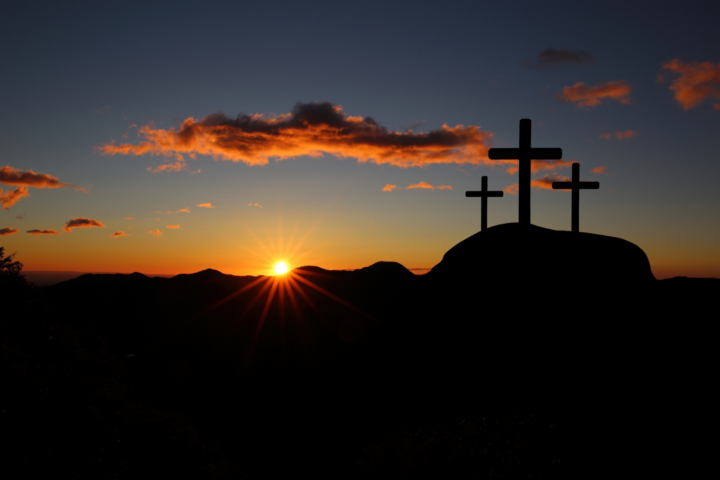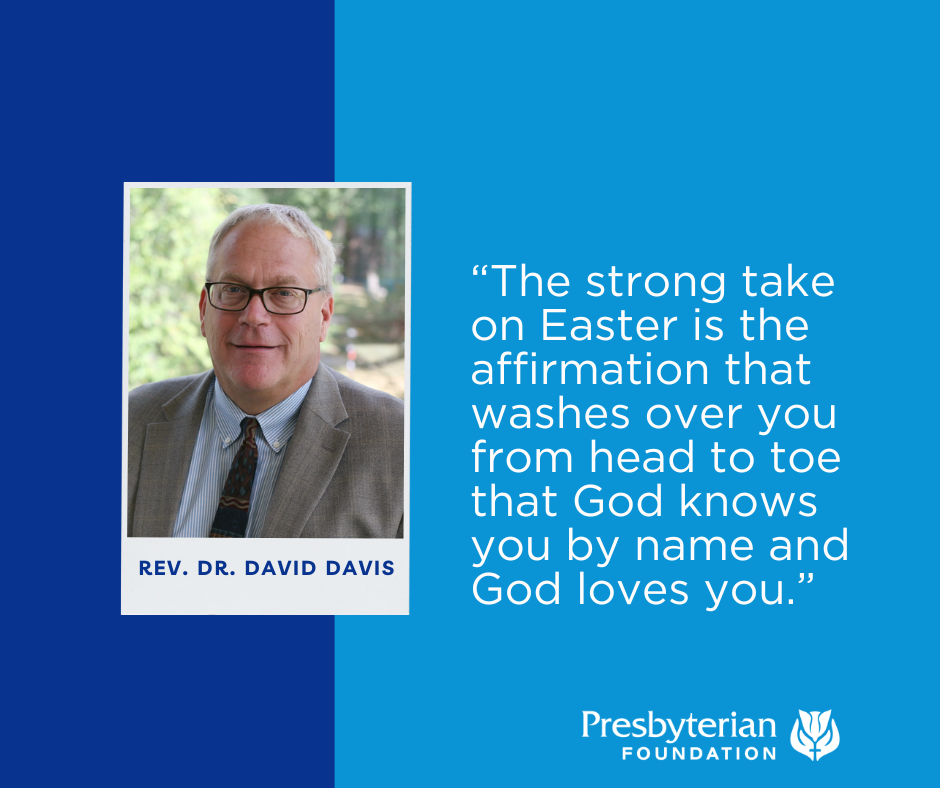3/18/2025
When Easter Comes in the Darkness – April 2025 Lectionary Preview, Year C, John 20: 1-18, Easter Sunday
by Rev. Dr. David A. Davis

“Early on the first day of the week, while it was still dark,” John writes, “Mary Magdalene came to the tomb.”
“While it was still dark”
The other three gospels are very clear that Easter starts at the break of day:
- “as the first day of the week was dawning” (Matthew);
- “very early on the first day of the week, when the sun had risen” (Mark);
- “on the first day of the week, at early dawn” (Luke).
But not John: “Early on the first day of the week, while it was still dark, Mary Magdalene came to the tomb.”
Still dark. Really dark.
Darkness in John’s gospel has little to do with the time of day. Darkness has everything to do with all that is opposite to the mighty works of God. All the powers and principalities that work to destroy life; life in all fullness as Jesus said in John. Darkness is the symbol, the sum, the prototype, the theme, the weight, the rallying cry in John for all that works against God, God’s reign, God’s kingdom. Mary came to the tomb when it was still dark. In John’s gospel, darkness IS death. Tomb. Dark. That’s death squared.
This isn’t dark as when a concert hall is empty for the evening with nothing scheduled, “the hall is dark.” This isn’t dark as when you are at a theater for an Anton Chekhov play that is so depressing and there’s so much yelling that you consider leaving at intermission, saying to your seatmate, “it’s too dark.” This is the kind of dark that comes amid the bright lights of a hospital waiting room. When butterflies in your stomach doesn’t begin to describe it. As you wait for the doctor and you keep trying to tell yourself this is all a dream, this can’t be happening! This is the kind of dark that tomorrow brings when it takes absolutely every ounce of courage in you to stay sober today. The dark that comes when your grandchild tells you about the mean kids at school and you can’t find any words to make them feel better. The dark that comes as the person you love like no other starts to fade before your eyes. Dark like that walk from the car to the grave in the cemetery that no one can avoid because of the absolute finality and boundless reach of death. It was still dark.
And Mary went alone. Here in John, she went alone. No mention of Mary the mother of James or of Salome. No reference to the other women. No use of plural pronouns. Mary was alone in all that darkness. She stood outside the tomb all alone weeping. She was not full of fear and great joy. There was no terror and amazement. She was not perplexed. She was weeping. John tells four times she was weeping. Mary stood weeping. As she wept, she bent over the tomb. The angels asked, “Why are you weeping?’ The Risen Jesus asked her, “Why are you weeping?” Weeping. Weeping. Weeping. Weeping. She wasn’t crying. This wasn’t shedding a few tears. She was weeping.

When I was a very young boy, my brother who was 21 at the time was killed in a car accident. I can still hear my mother weeping. I would be outside in the backyard and I could hear her inside weeping. I would wake up in my bedroom next to theirs, and I could hear her weeping in the night. I can hear that sound of weeping like it was just last night.
Mary’s tears were the kind of tears you can hear. She didn’t just bend over to look in that tomb. She was doubled over in grief, anguish, lament. Humanity’s brutal force has killed him and now taken him too. He was gone. Everything was gone. It WAS finished. Mary weeps not just for herself but for everyone, for all, for every single one who has stood alone, surrounded by death and darkness and who has wailed in the face of the utter absence of God.
And that’s when Jesus asks. He asks, “Why are you weeping?”
The hot take on the question is to assume Jesus is offering a “there, there, there Mary” with a pat on the back and a few “mansplaining, Jesus-splaining,” condescending words like “we all know how this going to end. I’ve been telling you forever how this ends. Mary, Mary, you just don’t get it.” A flippant take on the question is to portray Jesus as a frustrated. “Mary, it’s me, I’m here. I’m standing right here! Uh, Hello.” The strong take, the faithful take, the compelling take on Easter morning is to realize with the first words spoken by the Risen Jesus in John’s Gospel he asks after her tears. He acknowledges her tears. He hears her tears. Her tears and ours. He asks. Jesus asks.
And only then comes her name. Then he says her name. He calls her by name. With all those tears, and the piercing reality of darkness and death that proclaims the absence of God, the resurrection promise comes with her name. Before Mary offers the first Easter morning sermon, before she says, “I have seen the Lord,” Christ affirms his resurrection presence with her name. No trumpet blast. No angel declaration. No earthquake. Just her name. Standing in the very vortex of despair, death, sin, abandonment, hopelessness, judgement, and hell, the Savior called her by name. God knew her by name. And the message was then and forever announced. That Christ is Risen! He is Risen Indeed!
Some years, like this year, the Easter acclamation is a daring, defiant word of hope unleashed on a world that seems increasingly to look like anything but “thy kingdom come on earth as it is heaven.” When the darkness in our day-to-day life all around us is so magnified, the Easter acclamation comes with a louder shout. Christ is Risen! He is Risen Indeed! As the powers and principalities of this world rage, Easter’s call and response is also a plea deep within. A yearning of the soul, a cry of the heart, between you and the Living God. A longing to hear the voice of Christ Jesus call you by name. For Christ to ask after you and remind you again that resurrection power always and forever shall conquer the darkness. As John proclaims in his prologue, “the light shines in the darkness, and the darkness did not overcome it.” (John 1:5)
Christ is Risen! He is Risen indeed!
The strong take, the faithful take, the compelling take on Easter morning is not about telling people about an empty tomb. It is not about winning some argument at dinner about the bodily resurrection. It is not about pretending death is not real. Pastors and congregations have all have been to the grave too many times together to think we can fool each other. It’s not even about trying to convince the world or your cousin Phil that Jesus rose from the dead. No. The strong take on Easter morning is the awareness of the mystery and an acknowledgement of what will never be explained.
Christ is Risen! He is Risen indeed. The strong take on Easter is the gratitude deep within for God’s presence in life and in death.
Christ is Risen! He is Risen indeed. The strong take on Easter is the affirmation that washes over you from head to toe that God knows you by name and God loves you.
Today and forevermore! Christ is Risen! He is Risen indeed! The strong take on Easter is to live resurrection hope in the here and now while it is still dark.

